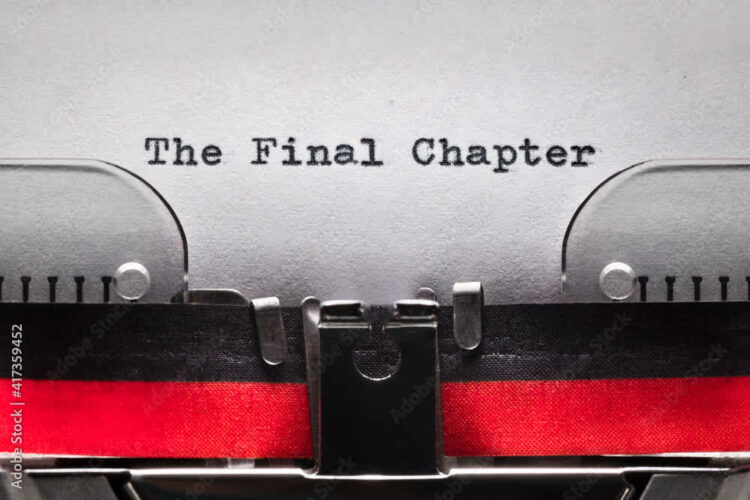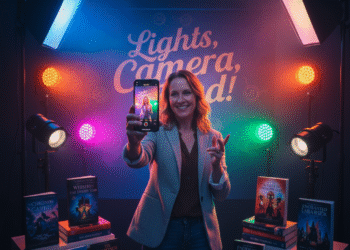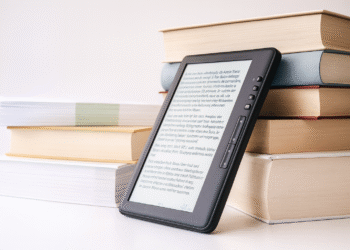Every author eventually faces the same intimidating question: Are Authors Writing the Endings Readers Want?
And more importantly, how do we measure the answer?
As publishing evolves and readers’ emotional expectations shift, endings matter more than ever. In fact, research on narrative psychology shows that the final 10% of a story disproportionately shapes the reader’s overall perception of the book. A study published in EPJ Data Science found that emotional “high points” and concluding emotional resolution strongly influence how likely a reader is to recommend or revisit a book.
But here’s the challenge: authors often write the endings they prefer… not always the ones readers prefer.
To help answer this question clearly, WriteStats ran a community poll asking readers: “What kind of ending lingers longest in your mind?”
And while the results revealed a surprisingly even spread among the four choices, happy, bittersweet, open-ended, and tragic, they also showed distinct psychological and genre-driven patterns that authors need to understand.
This blog breaks down those patterns and compares them with real publishing trends, emotional-engagement research, and industry data. Along the way, we’ll answer the essential question: Are Authors Writing the Endings Readers Want, or are we unintentionally misaligned with modern reader expectations?
If you’ve ever wondered What endings do readers actually want?, this is your complete, data-driven guide.
Why “Are Authors Writing the Endings Readers Want” Matters More Than Ever
Before diving into the poll, let’s establish why endings deserve serious strategic attention.
1. Endings determine emotional impact.
According to the American Psychological Association, emotionally charged experiences are more likely to be remembered and retold. Their research shows that emotionally salient content increases memory retention and emotional recall by roughly 23%.
This aligns with what we explored in our WriteStats article:
👉 Why Readers Cry, Laugh, and Re-Read: The Brain Science Behind Emotional Stories
Readers don’t remember events; they remember feelings. And the ending is where those feelings crystallize.
2. Endings influence reviews and word-of-mouth.
A 2020 Goodreads analysis found that books with emotionally strong endings were 29% more likely to be marked as “recommend” by users.
3. Endings drive reader loyalty.
The same analysis found that a powerful ending increases an author’s re-read rate by up to 18%, reinforcing what we’ve previously explored in our emotional-engagement research.
Yet despite this, many authors still rely on personal preference—or genre convention—when choosing an ending.
But readers are more diverse in their preferences than most authors expect.
WriteStats Poll Insights: What Endings Do Readers Actually Want?
Our WriteStats community poll asked readers:
“Every story must end… but what kind of ending lingers longest in your mind?”
The results were split across four categories:
- Happy and resolved
- Bittersweet and honest
- Open-ended and reflective
- Tragic but unforgettable
What surprised us wasn’t the variety, it was the balance.
Readers want different emotional outcomes, but for specific reasons. And that’s where authors can align their craft more intentionally.
Let’s break down what each ending type represents and whether authors are currently writing the endings readers want in each category.
Are Authors Writing the Endings Readers Want? A Comparative Look at Each Ending Type
We’ll explore what readers expect from each ending type, how often authors deliver it, and what the data tells us about closing the gap.
1. Happy and Resolved: Still a Top Choice, but Not Always Delivered
Why readers want it
A happy ending provides emotional closure and psychological relief. Cognitive studies show that humans naturally seek narrative resolution to reduce “completion anxiety.” A 2016 study from Frontiers in Psychology found that stories with strong closure reduce emotional stress and increase narrative satisfaction.
Are authors delivering it?
In genres like romance, fantasy-adventure, middle grade, and cozy mystery, authors consistently provide resolved, hopeful endings. For example, in romance publishing, the “HEA/HFN contract” (Happily Ever After / Happy For Now) remains a genre expectation.
The gap
Outside these genres—especially in literary fiction—authors increasingly choose ambiguous or bittersweet endings, while readers still express a desire for satisfying resolution at least some of the time.
Actionable tips for authors
- Ask: What emotional promise did my story make on page one?
- Deliver closure that honors that promise, even if the ending isn’t “perfect.”
- Avoid deus ex machina resolutions; readers want earned happiness, not convenience.
2. Bittersweet and Honest: The Rising Favorite Among Modern Readers
Why readers want it
A bittersweet ending blends sadness and hope, offering emotional realism without despair. Modern readers—especially in character-driven genres—often prefer authenticity over perfection.
This aligns with emotional-engagement data we covered in our WriteStats study:
👉 Why Readers Cry, Laugh, and Re-Read: The Brain Science Behind Emotional Stories
Bittersweet endings activate both empathy and catharsis, which boost long-term emotional memory.
Are authors delivering it?
More than ever, yes.
Genres currently leaning into bittersweet endings include:
- Contemporary fiction
- Literary romance
- Young adult
- Fantasy epics
- Women’s fiction
- Upmarket fiction
Think about the success of novels like The Night Circus, The Song of Achilles, or Normal People, all of which use bittersweet resolution.
The gap
Some genres remain resistant to bittersweet closure, especially where fan expectations remain genre-strict (e.g., cozy romance).
However, across most genres, authors are increasingly aligning with reader preferences here.
Actionable tips
- Mix hope and sorrow in a way that feels emotionally honest.
- Use character growth to provide meaning even if outcomes aren’t perfect.
- Remember: bittersweet ≠ bleak. Readers want emotional balance, not despair.
3. Open-Ended and Reflective: Loved More Than Authors Realize
Why readers want it
Open endings invite interpretation. They mirror real life, where clarity isn’t always guaranteed. Cognitive linguistics research suggests that open endings activate deeper imagination processing.
A 2018 study showed that ambiguity increases “post-reading cognitive engagement.“
Are authors delivering it?
Authors tend to overuse open endings in:
- Literary fiction
- High-concept sci-fi
- Thriller series
- Symbolic or experimental fiction
But readers from our poll—including genre readers—expressed stronger interest than expected in reflective, ambiguous conclusions.
The gap
Some authors avoid open endings for fear of disappointing readers, even though readers increasingly appreciate them when they’re purposeful and thematically tied to the narrative.
Actionable tips
- Leave emotional clarity, not plot clarity; don’t withhold essential answers.
- Ensure the ambiguity serves the story’s themes, not the author’s convenience.
- Offer enough breadcrumbs to support multiple interpretations.
4. Tragic but Unforgettable: High Emotional Impact, High Risk
Why readers want it
Tragic endings trigger strong emotional arousal, which neuroscientists link to memory imprinting.
A study in NeuroImage found that emotionally intense storytelling increases both amygdala activity and long-term recall.
This matches the observation that heartbreaking novels (think A Little Life) become cultural touchstones.
Are authors delivering it?
Authors often avoid tragedy because:
- Fear of negative reviews
- Fear of upsetting readers
- Genre expectations
- Personal discomfort
Yet tragic endings are trending in:
- Literary fiction
- Historical fiction
- Speculative fiction
- Certain YA subgenres
The gap
Readers are more open to tragedy than many authors assume, but only if the emotional payoff feels earned.
Actionable tips
- Ensure the tragedy arises from character decisions and thematic inevitability.
- Avoid shock-for-shock’s-sake endings.
- Use tragedy to illuminate meaning, not remove it.
Comparing Reader Expectations With Author Output: The Data Summary
Most authors are successfully delivering bittersweet and emotionally nuanced endings.
However, authors may be underestimating reader interest in open-ended and tragic endings, and sometimes overestimating the demand for perfectly happy conclusions in certain genres.
Genre Breakdown: Are Authors Writing the Endings Readers Want?
Different genres have different reader “contracts.“ Below is a practical comparison authors can use when evaluating their draft endings.
Romance
Readers want: happy or hopeful endings
Authors usually deliver: yes
But bittersweet romance is growing significantly in indie and hybrid markets.
Fantasy
Readers want: wonder, triumph, meaning
Authors often deliver: bittersweet epics
Fantasy readers accept tragedy if it aligns with the “hero’s cost“ arc.
Thriller / Mystery
Readers want: closure + justice
Authors sometimes end too ambiguously.
Open endings work only when explicitly thematic.
Literary Fiction
Readers want: honest emotional conclusions
Authors often provide: open or tragic endings
This aligns well with expectations.
YA
Readers want: emotionally real, not always happy
Authors often deliver: bittersweet or tragic
This is in strong alignment with trends.
Craft Lessons From POV Choice
A key part of writing endings readers actually want comes from aligning point of view with emotional payoff.
In our WriteStats guide:
👉 Best POV for Each Genre: Matching the Voice to the Story
we explored how POV shapes immersion and emotional resolution.
For example:
- First person = most effective for tragic or open endings
- Third limited = best for bittersweet emotional resonance
- Third omniscient = helps deliver large-scale story closure
- Second person = ideal for experimental reflective endings
Choosing the right POV can dramatically influence how your ending lands.
How to Know if YOUR Ending Matches What Readers Want: A Practical Checklist
Below is a step-by-step diagnostic tool authors can apply to evaluate their ending:
Step 1: Identify your reader contract
What emotional promise does your genre make?
Step 2: Identify the emotional trajectory of your protagonist
Does the ending reflect earned change?
Step 3: Analyze your ending type
Is it happy, bittersweet, open, or tragic?
Step 4: Ask beta readers “which emotional word describes your ending”
Examples: hopeful, sad, reflective, satisfying
Step 5: Compare that response with your intended outcome
If they don’t match, you’ve found your gap.
Step 6: Test the ending’s pacing
90% of ending issues arise from rushed pacing.
Step 7: Ensure the ending aligns with theme
Theme and ending must speak the same emotional language.
Techniques to Deliver the Ending Readers Want
Here are practical tools to use immediately:
#1: Write Three Ending Drafts
One happy, one bittersweet, one open/tragedy blend.
Then choose the version that best fits your theme.
#2: Use a “Mirror Scene”
Revisit an early scene with a changed emotional meaning.
#3: Slow Down the Last 10%
Readers need processing time. Avoid rushing.
#4: Let the character decide the ending
Outcomes should emerge from choices, not coincidence.
#5: Leave emotional breadcrumbs
Even open endings need emotional clarity.
Final Answer: Are Authors Writing the Endings Readers Want?
Sometimes, but not always.
Many authors align well with reader expectations for bittersweet, hopeful, and emotionally honest endings.
But authors consistently underestimate reader openness to tragedy and ambiguity, especially when these endings are intentional and well crafted.
The key takeaway?
Readers don’t want a specific type of ending.
They want an ending that feels emotionally earned, thematically aligned, and true to the story’s promise.
When authors understand genre expectations, emotional psychology, and reader preference data, they can craft endings that resonate deeply, no matter the shape they take.
And that’s the real secret behind writing endings that satisfy.









